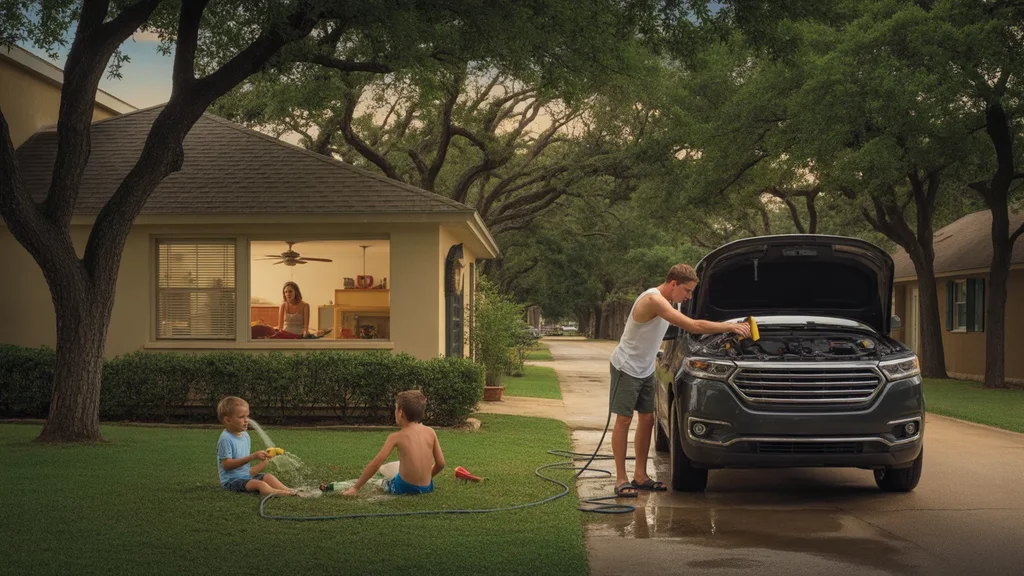When the Robinsons opened their July electric bill, they were shocked. “How is our bill $315?” Lori asked, fanning herself in the Texas heat. “I knew utility costs in Georgetown were high, but this is crazy for a month of A/C!”
If you’re a Georgetown resident bracing for summer energy bills, the Robinsons’ story might sound painfully familiar. With long, scorching summers, cooling costs can catch even seasoned Texans off-guard. Let’s break down what to expect and how to keep your bills in check.
What Summer Power Costs Look Like in Georgetown
In Georgetown, the average household electric bill spikes dramatically in the summer months. Based on usage data from the City of Georgetown Utility Systems, here’s the typical monthly damage:
- June: $180
- July: $210
- August: $205
The average July electric bill in Georgetown is about $210, nearly double the $110 residents pay in milder months like April and October. For larger homes or those with older, inefficient A/C units, midsummer bills can easily top $300.
So why the painful summer sticker shock? A few key factors are cranking up the cost of keeping cool in Georgetown.
Why Are Energy Bills So High in Georgetown During the Summer?

There’s no way around it—cooling a home in Georgetown’s subtropical climate is expensive. Average summer highs hover in the mid-90s, and heat waves can push temperatures over 100°F for days or weeks at a time.
All that A/C use adds up fast, especially in older homes with poor insulation. Combine high cooling demand with rising electricity prices, and you have a recipe for budget-busting bills. Other summer-specific costs can pile on too, like:
- Increased use of ceiling fans and portable fans
- Pool pumps and filters running overtime
- Landscape irrigation to keep grass from scorching
- Kids home using electronics and appliances more
In Georgetown’s competitive housing market, many residents are also moving into larger, newer-construction homes. While more efficient than older models, big houses mean more square footage to cool—and more cooling means higher costs.
Sample Monthly Bill Breakdown
To see how cooling impacts summer electric bills, check out this sample cost breakdown for a typical 1,800 square foot Georgetown home in July:
| Usage Category | Percent of Bill | Estimated Cost |
|---|---|---|
| Cooling | 55% | $115 |
| Appliances & Electronics | 20% | $42 |
| Water Heating | 12% | $25 |
| Lighting | 8% | $17 |
| Other | 5% | $11 |
Based on 1,800 sq ft home with average A/C use and a total July electric bill of $210.
As you can see, cooling accounts for over half the total bill during peak summer months in Georgetown. For many homes, that percentage can be even higher, especially during prolonged heat waves.
Ways to Lower Summer Energy Bills
While there’s no magic bullet for cutting cooling costs, Georgetown residents have options to ease the summer squeeze on their wallets:
- Upgrade to a smart thermostat to optimize your A/C usage and avoid wasted energy.
- Seal and insulate ducts to prevent cooled air from escaping into your attic or walls.
- Use ceiling fans and portable fans to supplement A/C and allow a higher thermostat setting.
- Close blinds and curtains during the day to block solar heat gain through windows.
- Plant shade trees strategically around your home’s exterior to provide natural cooling.
🏆 Energy Tip: Set your thermostat to 78°F during the day when you’re home and a few degrees higher at night or when away. Every degree above 72°F can save 3-5% on cooling costs!
Time-of-Use Pricing in Georgetown
Some utility providers offer time-based discounts to encourage energy use during off-peak hours. These “time-of-use” rates charge less for power used at night or on weekends when overall electricity demand is lower.
Currently, the City of Georgetown Utility Systems does not offer a residential time-of-use program. However, as the city’s population and energy use grows, pilot programs or off-peak incentives may be considered in the future to help manage the Texas power grid.
Summer Cooling FAQs
Still have questions about keeping your cool without draining your bank account? Here are answers to some common summer energy concerns in Georgetown:
Q: How much more are summer electric bills compared to spring?
A: Summer bills in Georgetown average about 80-90% higher than in the spring months of April and May. Cooling costs are the main driver, accounting for over half of the typical July bill.
Q: Does solar reduce summer energy costs?
A: Yes, a appropriately-sized solar PV system can significantly offset summer energy costs. South and west-facing panels will generate the most electricity during peak cooling hours. Many Georgetown homes can reduce their net energy costs by 50% or more with solar.
Q: What’s the best thermostat temp for saving money in summer?
A: For the best balance of comfort and savings, the U.S. Dept. of Energy recommends setting your thermostat to 78°F when you’re home and awake, and a few degrees higher when away or asleep. Aim to keep the temperature difference between inside and outside to 20 degrees or less.
Smart Cooling Prep for Georgetown Summers
For most Georgetown residents, summer cooling costs are a major expense to budget and plan for. By taking proactive steps in the spring, you can keep those hot-weather bills from burning through your budget:
- Schedule a professional A/C tune-up in April or May to keep your system running efficiently
- Consider investing in upgraded insulation, smart thermostats, or energy-efficient windows
- Review your electricity plan and shop for lower summer rates if you have a variable plan
- Set a budget for summer utility costs and look for ways to offset increases elsewhere
While triple-digit bills are the norm for summer in Georgetown, small changes can add up to real relief. By understanding your usage, planning ahead, and making smart home improvements, you can keep your family cool without breaking a sweat over costs.
